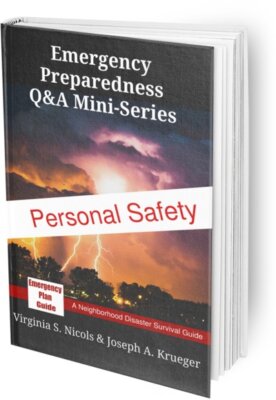Smash and Grab – Worse this year!

It’s not too often that I add a new topic to our list of Advisories. So much of emergency preparedness is just getting smarter and more secure around the basics. This week, however, I have felt obliged to add a new threat for you to consider: a Smash and Grab incident!
Over the past few days of Black Friday shopping frenzy, a handful of major cities have experienced dozens of violent Smash and Grab incidents. Teams of people, clearly organized and prepared with crow bars and hammers, violently invade upscale stores, breaking windows and display cases, and making off with thousands of dollars of high-end merchandise. Within minutes, they are gone.
A security guard was shot and killed as he defended a video team filming the violence. So far, though while shoppers’ packages have been snatched by the mobs, no shoppers have been reported injured.
But it’s likely only a matter of time before a shopper or staff member is in the wrong place at the wrong time, or makes the wrong move. We don’t want that someone to be you!
Can I prevent a smash and grab incident?
It’s not clear that there is any way to prevent such an incident. Certainly, mall and store security has been beefed up. But the snatch and grab gangs swoop in and get out before law enforcement personnel can get there.
You might avoid being caught up in an incident by shopping during daylight hours. And it would be a good idea to shop in smaller local stores rather in malls or big box stores. (These thieves seem to be drawn by wide aisles, lots of merchandise, multiple ways out, and easy escape routes for their cars.)
Practice situational awareness all the time to help keep yourself out of harm’s way!
We’ve written before about situational awareness. Its simplest definition? Being more aware of what’s going on around you!
The more complete definition of situational awareness for personal protection includes:
- Gather information about your environment.
- Understand what you see, feel, hear, etc.
- Predict what could happen and come up with options for how you could react. (Use your imagination!)
- Be ready to take action if you feel unsafe.
Now, this should all make sense to you, and you could probably follow all these steps if you knew in advance that you were heading into trouble. The challenge is to maintain situational awareness ALL THE TIME!
You can practice! And the more you do, the easier it becomes. (As I have mentioned before, Joe has had training in military intelligence. Situational awareness is built right into him!)
Shopping presents particular threats.
Even if you don’t get caught up in a smash-and-grab incident, you may be broadcasting an invitation to a thief. Are you guilty of any of these shopping-associated behaviors?
- You just bought that perfect and very expensive gift you’ve been looking for! As you push your way through the crowd you are exchanging excited video calls with your girlfriends and telling them just what a great discount you got!
- You’re finished with your shopping. You pretty much stagger into the parking garage so loaded down with parcels and packages you can hardly see over them. You don’t even notice who is coming toward you in the shadows.
- Your shift is up. You’re the last person out of the store tonight, and you head into the nearly empty parking lot alone. All you can think about is getting home and getting out of those shoes.
In every case above, your lack of situational awareness has turned you into a potential victim!
What if I happen to be in a store when a gang of smash-and-grabbers comes in?
I mentioned that Joe has had valuable experience in staying aware. His experience has been catching!
Every time I go into ANY building I always make the effort to identify ways to get out other than the way I came in. In a grocery store, that’s back through the loading area. In a retail store, I look for signs for restrooms and emergency exits. (Since we’re in California, I also automatically and continually look for places to shelter in an earthquake.)
In a smash-and-grab situation you may suddenly notice people pouring into the store. You may hear breaking glass. If you’ve already identified other exits, move away from the turmoil and toward those exits if you can!
If you can’t get away, try to remain unnoticed. Stay out of the way. Don’t scream or fight. Let them take your packages if they want them. (If you paid by credit card you may get your money back thanks to “purchase protection!” Check to see if your card has it!)
Remember, the smash-and-grab mob is not interested in you. They want things — preferably expensive things like jewelry or electronics that can be resold over the internet. They also want to get their loot and get out quickly, so any person that gets in their way is likely to be fiercely attacked.
This holiday season is turning out to be unlike any other.
Over the past few months we have all witnessed more mass shootings, more bomb threats, more erratic driving, and more angry confrontations than I can ever remember. The smash-and-grab incidents fall right into this wave of violence. So a refresher on situational awareness is timely.
I have a couple of recommendations for that refresher.

First, our own Mini-Book on Personal Safety devotes 4 of its 17 questions to situational awareness. Each one of the answers offers up some detailed ways you – and your kids — can practice getting better at it!
(I got a nice email from an emergency management professional who said he was impressed to have “found new info” there about how to practice!)
Here’s the link to Personal Safety on Amazon. A perfect and inexpensive gift for every member of the family!
Second, as part of the research for today’s Advisory I discovered three videos on YouTube from Homeland Security. They are games to test just how accurately you see things! Now, you may not do very well on #1, but by the time you’ve finished #3, you will have improved! Going through them takes less than 15 minutes and it’s fun!
I have relied on news reports for much of this Advisory. If your local police offers tips for safe shopping, or a special press release on smash and grab incidents in your community, be sure to find out more. You may prefer to approach certain shopping areas with extra caution.
That’s it for this week. But the role of situational awareness doesn’t go away. Commit to improving your own skill!
Virginia
Your Emergency Plan Guide team
P.S. Our personal safety book covers a lot more than mindset. If you’re considering self-defense systems, you’ll find questions about martial arts, weapons and deadly weapons, too. It all has to do with gaining more control over your personal safety.




